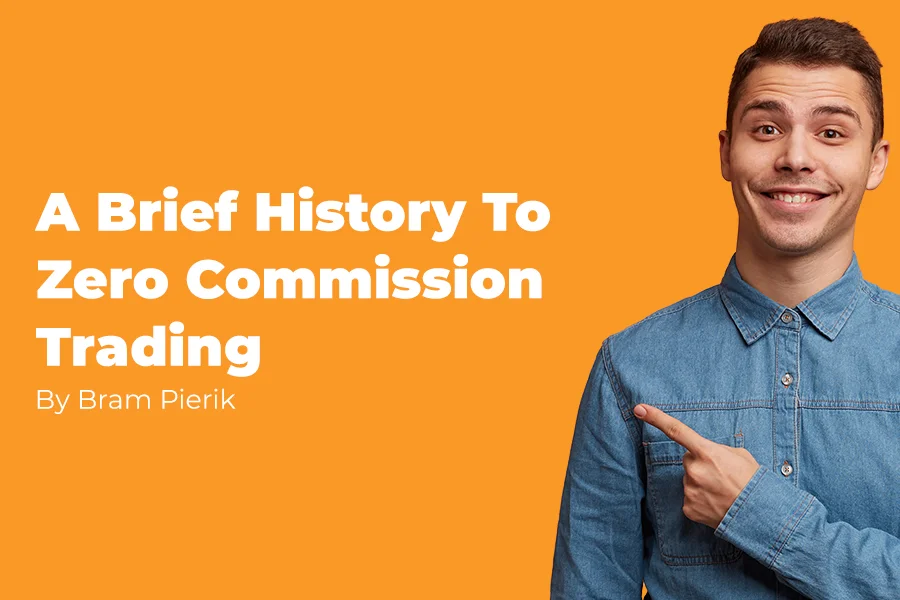This zero commission trading global phenomenon is something all day traders should appreciate, so I’ve outlined a brief history of this change, inspired by the Stephen Mihm book: ‘The Death of Brokerage Fees Was 50 Years in the Making’.
It is worth noting that zero commission trading still does include some transactional costs but overall trading costs may be reduced significantly when a trader does not have to pay commission.
Before Zero Commission Trading.
Post 2020, it would be hard to imagine the kind of commissions that a broker/dealer charged back in the 70s and 80s. Back then, there certainly wasn’t zero commission trading. Instead, some broker/dealers were required to charge customers a minimum commission rate, most of the time a percentage of the par value of shares traded. For a long period of time, fixed rates commissions were the norm, but in the 1960s the brokerage fee structure began to come under pressure. The key was the rise of institutional investors.
Big players like insurance companies and pension funds accounted for only a fifth of total trading volume in 1950; a decade later they accounted for a solid majority. Broker/dealers welcomed them. After all, they got a far larger commission with the buying and selling of large blocks of shares.
On May 1st 1975, the NYSE abolished fixed rates. From here on with competitive pricing brokerage fees declined as much as 50 percent. The ordinary investors were still left in the dark which opened the door for discount broker/dealers. In 1985 more than 600 discount broker/dealers were operating and luring away investors from conventional stock brokerages. This greatly helped to democratize stock market participation. Throughout the years trading costs fell more and more ordinary people started to invest their money. The rise of electronic trading, which allowed traders to trade stocks online, helped the decline in trading fees as well but the 1975 decision was the cornerstone of it all. And now market participants can enjoy zero commission trading.
TradeZero Terms For Zero Commission Trading
The zero commission trading terms offered by TradeZero have slight variations depending on which of their brokers you have an account with. Below is a breakdown of these differences. Click the respective links for full clarity on terms of service.
- Day traders in the USA who trade with TradeZero America can avail of zero commission trading on all limit and market orders with TradeZero. The security in question must trade at $1 or greater and also must trade on the NYSE, AMEX or NASDAQ. Keep in mind U.S. pattern day trading rules require day trading accounts to maintain at least $25,000 in equity in their account in order to be able to trade. The time must also be after 7 AM EST to qualify for commission free orders with TZA.
- For TradeZero residents of Canada, zero commission trading is available for all limit orders. The symbol in question must trade at $1 or greater, must trade on the NYSE, AMEX or NASDAQ and the limit order must not create an immediate match. The order must also be for 100 shares or more.
- For those day traders who use TradeZero International, all limit orders are zero commission provided they do not create an immediate match, trade at $1 or more on the NYSE, AMEX or NASDAQ and the order is for 200 shares or greater.
That concludes my brief history from the 1970s to now: the zero commission trading era. Now, day traders live in a democratized world where trading is accessible and affordable to many more people.
Disclaimer
This content (“Content”) is produced by Bram Pierik. The Content represents only the views and opinions of Mr. Pierik. Mr. Pierik’s trading experiences and accomplishments are unique, and your trading results may vary substantially. TradeZero does not endorse the Content and makes no representations or warranties with respect to the accuracy of the Content or information available through any linked third party sites. The Content has been made available for informational and educational purposes only and should not be considered trading or investment advice or a recommendation as to any security. Trading securities can involve high risk and potential loss of funds. Mr. Pierik is compensated by TradeZero for producing the Content and may also receive compensation for customers he introduces to TradeZero.
TradeZero provides self-directed brokerage accounts to customers through its operating affiliates: TradeZero America, Inc., a registered broker-dealer and a member of FINRA and SIPC; TradeZero Inc., a dealer registered with the Securities Commission of the Bahamas; and TradeZero Canada Securities ULC, an IIROC member firm and member of CIPF.
Bibliography
Stephen Mihm. (2020, Jan 3). The Death of Brokerage Fees Was 50 Years in the Making. Retrieved from Bloomberg: https://www.bloomberg.com/opinion/articles/2020-01-03/how-nyse-went-from-quasi-cartel-to-zero-fee-stock-trading
TradeZero. (2022, Sept 1). How To Get. Retrieved from TradeZero: https://us.tradezero.co/freetrades
